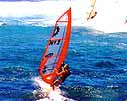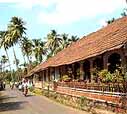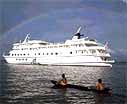|
|
|
 Panaji : Panaji : |
 Panaji The capital of Goa & headquarters of North Goa District, a small and charming city on the left bank of silvery Mandori River, with beautiful red-roofed houses, built in Latin style, also boasts of many modern houses, well laid gardens, statues and avenues lined with Gulmohar, Acassia & other trees. Enchanting panorama unfolds from atop Altinho (Hill Top).
Panaji The capital of Goa & headquarters of North Goa District, a small and charming city on the left bank of silvery Mandori River, with beautiful red-roofed houses, built in Latin style, also boasts of many modern houses, well laid gardens, statues and avenues lined with Gulmohar, Acassia & other trees. Enchanting panorama unfolds from atop Altinho (Hill Top).
|
|
 MAPUSA : MAPUSA : |
 A small town clustered around the Mount (Alto) is Mapusa. It forms the hub of north Goa with an even blend of residential and commercial establishments. Its 13 kms away from Panaji, a sharing taxi or a bus will take you there. Known popularly for its Friday market, people from all over Goa come here to buy and sell their wares. You will also get plants and saplings, ready spiced Goan pork sausages, dried fish and prawns, clothing, junk jewelry, and the famous country liquor, all sold at the most reasonable prices you could possibly find.
A small town clustered around the Mount (Alto) is Mapusa. It forms the hub of north Goa with an even blend of residential and commercial establishments. Its 13 kms away from Panaji, a sharing taxi or a bus will take you there. Known popularly for its Friday market, people from all over Goa come here to buy and sell their wares. You will also get plants and saplings, ready spiced Goan pork sausages, dried fish and prawns, clothing, junk jewelry, and the famous country liquor, all sold at the most reasonable prices you could possibly find.
|
|
 Pilar : Pilar : |
 Pilar is a village in Goa, India, some 10 km from the state capital Panaji. It is on a hill top and has a panoramic view of the Arabian Sea and the mountains all around. It is the headquarters of the Missionary Society of St. Francis Xavier Pilar, commonly called the Society Of Pilar. There are pilgrims who visit Pilar every Thursday to venerate the bones of venerable Fr. Agnelo, a priest of the above-said society who had lived a virtuous life.
Pilar is a village in Goa, India, some 10 km from the state capital Panaji. It is on a hill top and has a panoramic view of the Arabian Sea and the mountains all around. It is the headquarters of the Missionary Society of St. Francis Xavier Pilar, commonly called the Society Of Pilar. There are pilgrims who visit Pilar every Thursday to venerate the bones of venerable Fr. Agnelo, a priest of the above-said society who had lived a virtuous life.
|
|
 Margao : Margao : |
 Margao, the capital and the chief town of South Goa, has a decidedly Portuguese flavour and an old world charm. Margoa is also the commercial centre of South Goa. The "Math" of the Vaishnavas was first established here. In 1564, the early period of Christianisation, the Jesuits built a church, which was destroyed by the Mohammedans in 1571.
Margao, the capital and the chief town of South Goa, has a decidedly Portuguese flavour and an old world charm. Margoa is also the commercial centre of South Goa. The "Math" of the Vaishnavas was first established here. In 1564, the early period of Christianisation, the Jesuits built a church, which was destroyed by the Mohammedans in 1571.
|
|
 Vasco-Da-Gama : Vasco-Da-Gama : |
Vasco da Gama, 29-km by road southwest of Panjim, sits on the narrow western tip of the Marmagoa (also known as Mormugao) peninsula, overlooking the mouth of the Zuari River. Acquired by the Portuguese in 1543, this strategically important site was formerly among the busiest ports on India's west coast.

It remains a key shipping centre, with container vessels and iron ore barges clogging the choppy river mouth, but holds nothing of interest for visitors, particularly since the completion of the Konkan Railway, when Goa's main railhead shifted from here to Margao. The only conceivable reason one might want to come to Vasco is to catch a bus to Dabolim airport, of Bogmalo beach, 8-km southeast.
|
|
 Mormugao Harbour : Mormugao Harbour : |
 Mormugao is a city and a municipal council in South Goa district in the Indian state of Goa. It is Goa’s main port. Its appearance in the 1980 film The Sea Wolves is one of its few global advertisements, but it has a fascinating past. When the Portuguese colonised part of Goa in the sixteenth century, they based their operations in the central district of Tiswadi, notably in the international emporium City of Goa, now Old Goa. As threats to their maritime supremacy increased, they built forts on various hillocks, especially along the coast. In 1624 they began to build their fortified town on the headland overlooking Mormugao harbour.
Mormugao is a city and a municipal council in South Goa district in the Indian state of Goa. It is Goa’s main port. Its appearance in the 1980 film The Sea Wolves is one of its few global advertisements, but it has a fascinating past. When the Portuguese colonised part of Goa in the sixteenth century, they based their operations in the central district of Tiswadi, notably in the international emporium City of Goa, now Old Goa. As threats to their maritime supremacy increased, they built forts on various hillocks, especially along the coast. In 1624 they began to build their fortified town on the headland overlooking Mormugao harbour.
|
|
 Chandor (Chandar) : Chandor (Chandar) : |
 9 kms. East of Margao the menezes Braganza House, mostly late 18th Century and previously owned by Lemon nationalist and Journalist Luis De Menezes Braganza has a series of magnificent rooms especially the great salon with its fine furniture and the largest private library in Goa.
9 kms. East of Margao the menezes Braganza House, mostly late 18th Century and previously owned by Lemon nationalist and Journalist Luis De Menezes Braganza has a series of magnificent rooms especially the great salon with its fine furniture and the largest private library in Goa.
|
|
|